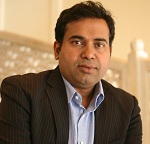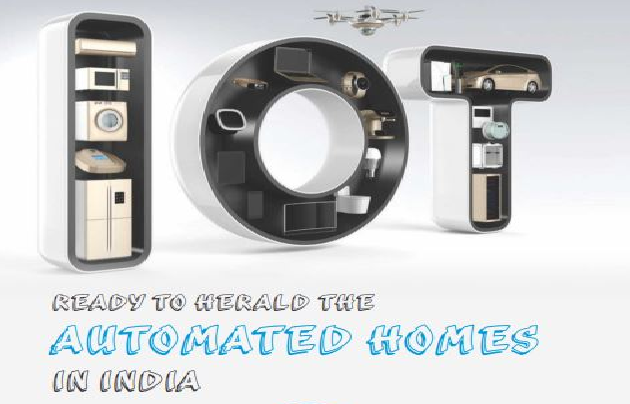Even when more than 80 percent of the global population have no inkling of what is Internet of Things or IoT is, it’s ever-expanding presence and fast rate penetration is visible all over from public spaces, factories, to homes and even outside and inside the human body. Smart Homes or Home Automation is steadily making its entrances in the urban dwellings, globally. Consumers are opting for features and devices at homes with making-life-easy factors like safety, efficiency and automation, and that work at the whims and commands of the users. Being the sole producer of the biggest pool of IT intelligence and software brains in the world, India is not absent in this picture. Here Abhijit Roy, Associate Director – IoT CoE, Happiest Minds, Rajeeb Dash, Head- Corporate Marketing, Tata Housing and Mahesh Lingareddy, Founder and Chairman, Smartron dedicated to IT solutions and Home Automation, respectively, shares their outlooks on IoT and Smart Home adoption and businesses in India. (Inputs given here are excerpts).
India as a prospective market for IoT and Smart Home devices for Cutting edge technology adoption:
Happiest Minds: ICT companies in India have truly been the pioneers in conceptualizing these IoT solutions and will be the key enablers for IoT in India. Some start-ups have started offering smart home solutions, but this segment is still devoid of any major player. In the past, telecom companies have made efforts to push in smart home solutions in India but owing to stiff competition their focus has wavered.
Mass market smart home solutions have not yet become popular in India, but there are some encouraging signs as I see a fresh approach brewing from telecom companies, appliance manufactures and even the Indian government along with IT companies which has been very encouraging of such initiatives. India is poised for IoT and Smart Home business growth and I think we have only realized the tip of the iceberg.
TATA Housing: With evolution of Indian consumers over the last decade along with the increase in spending capacity, Smart homes are now a reality in India and likely to be the next technological advancement that will grip the housing sector. The industry has seen a rise in demand in the Smart Homes segment as a result of increased awareness among homebuyers and a faster adoption of smart technologies. Smart home technologies have also become affordable and average households in India have started to adopt smart automation systems. These smart home features make living more comfortable, convenient, secure, entertaining, sustainable and enable a control of the house remotely. For an ideal Indian home buyer, security and safety are crucial aspects in a home. Therefore, devices and systems that offers solutions for security and safety have become more popular among the Indian consumers. As the country moves towards smart housing, home automation is likely to witness rapid evolution with faster adoption.
Smartron: The value proposition of smart home technology for Indian customers’ and homes must be aligned to the current mindset for the Indian consumer which may be very different from those in other markets like Europe and US. For example, security and safety will rank higher than energy savings on the value perception scale in the minds of Indian consumer. Thermostats which have been relatively quite successful in US market may not enjoy the same level of success in India. Therefore it becomes essential for Indian companies to work towards developing products and solutions that are suitable to the local market scenario. For Smartron, the tronX Home is that proposition and we are very positive that we will be able to bring in the best technologies and products for the smart homes in India. We are already working with a number of partners to develop sensors, switches and systems that can easily be incorporated in the Indian setup.
Popular Intelligent Home Technologies in India?
Happiest Minds: It’s my personal observation that in India most fledgling efforts at home automation adoption result from a need to ensure safe and secure homes. There are a plethora of camera vendors today in the Indian market with varying options offering local recording or cloud based surveillance. Safety requirement which is second in adoption priority have smart home devices which detect fire or smoke and even intrusion.
On the other hand, HNI customers are now tending to move towards convenience and wellness solutions apart from safety and security. Convenience use cases cover remotely operating home lights, fans, ACs or a smart TV and wellness devices such as fitness bands or a BP monitor that can already be found in the well to do homes.
TATA Housing: Some of the prominent home technologies that have gained high popularity in India are:
Lighting and Comfort Control: This enables the customer to control all devices like lights, air conditioners, heaters, window shutters, curtains, etc. automatically. It is also coupled with movement and presence detectors which can be used to economize electrical energy consumption. There’s also a gas leak detection notification that can be sent to the owner’s phone to ensure safety, over and above features such as indoor cameras that can stream live video to a smartphone.
Web based Security System: Security of luxury apartments especially second homes are critical considering the owner is likely to be away from the property most of the time. To ensure security of the apartments, infrared beams and burglar alarms can be setup to alert the security at site. There are installed IP based cameras (indoor and outdoor) which will help the owner to have surveillance on the property at any point of time by net login.
Visitor management access control system: Elevator control, monitoring door openings by providing access cards on external doors. Hot button system to inform security of site, Video door pones, etc.
Energy and eco-friendly management systems: Energy management system used to monitor and manage energy consumption. An extension of the smart home approach, rainwater harvesting systems, sewage treatment systems and organic waste convertors ensure that smart homes are also eco-friendly.
Smartron: There are a number of home automation platforms that are currently being used to develop products for homes in India. However it is not going to be about only the technologies. The key factor that will play a big role in adoption of the smart home concept will be how well these automation solutions solve some of the key problems for the Indian consumer: Security and safety, Utility Management and Energy efficiency and Entertainment Services.
Smart City Initiative in India and recommendations for strategic implementation
Happiest Minds: Smart Solutions are expected to use technology, information and data to make infrastructure, services and governance better. Central planning for implantation of Smart solution will be the key factor to achieve success in creating meaningful solutions or we will see a lot of overlap in services. There are too many interdependencies between any services and if this is not planned prior to implementation, we will end up creating vertical solution silos leading to deadlocks without a horizontal binding layer.
Defining a horizontal biding layer or a platform is critical as it serves as a master IT framework for implementing any smart solution which uniformly defines technologies, information storage and data representation.
TATA Housing: With innovation at the heart of Tata Housing’s philosophy, the company integrates latest technologies and trends to their business models as well as offerings. Spread across premium, luxury and affordable housing projects, digital elements are interwoven across properties to elevate a modern homebuyer’s experience. In the smart homes segment, some of the projects launched by Tata Housing include Myst in Kasauli, Prive in Lonavala and an affordable housing project in Noida.
Smartron: Smart cities hold a great promise to improve and elevate urban infrastructure of the top cities in India and create more smart cities easing out pressure on the four metros. Focus by government(s), simplification of process (quick decisions and faster clearances of projects), deeper industry partnerships and focus on the infrastructure problems will hold the key for success of smart city initiative in India.
Smart Home adoption in five 5 years down the line
Happiest Minds: Indian smart home realization will take a while after the underlying infrastructure such as internet connectivity, gets fully set up in 2-3 years at least in the metros, and tier 1-2 cities. The limited availability of internet directly impacts economies of scale and consequently adoption rates – two factors that are crucial to making smart home products more affordable to an Indian customer.
Meanwhile appliance manufacturers will be pushing hard to entice customers by introducing newer smart home features and retaining value in their products. Although for now these features may be a tad underdeveloped, by 2020 we will see proliferation of smart home offerings by solution providers which is not just limited to an individual device or appliance but is integrated with multiple social, ecommerce, concierge, logistics, promotional, entertainment and travel platforms.
TATA Housing: The building blocks of India’s 980 billion ‘Smart Cities’ program are smart homes built sustainably from the ground-up. To make smart city initiative a success, cities need to be constituted of several self-sustained, automated mechanisms that push the boundaries of existing technologies available in cities and homes. The concept of ‘smart’ must be blended in the soul of a smart city. Each building block should be placed with this concept at the heart of it – building blocks that lead to smart homes being created to fulfil the goal of a smart city. The benefits of smart cities are intangible. From improving air quality, to reducing electricity bills and helping create an ecosystem that’s easy on the environment.
Smartron: Smart home adoption in India will take at least a few years for it to become mainstream. One of the main reasons for this is the gap between what the Indian consumer demands/requires and what the brands that are in the home automation space, are offering at the moment. Most of the products that are available in the market are either highly unaffordable or complex and only for the tech enthusiasts/early adopters.
However, in the next few years we believe the market will be led by a home-grown product company that solves more Indian market relevant problems and builds a scalable ecosystem rather than just bringing products from other markets to India. The smart home products and solutions must meet a certain price point for the Indian consumers and therefore local design, engineering and manufacturing will play a vital role in the business model to be successful. Smartron is working on building such an ecosystem of not just smart home products but also services that are most relevant for the Indian market. tronX Home is the smart home offering from Smartron that goes beyond just connecting a few devices in the house. tronX Home helps control locking mechanisms, security updates, home appliances, services like water, electricity & payment modules for these services, all available through a Voice Activated Assistant.
Major roadblocks in accelerating an Intelligent Home Market
Happiest Minds: One of the major roadblocks I see is the level of internet penetration in India. We need to make connectivity ubiquitous and affordable for enabling Smart Home solutions in a true sense. Telecom operators will play a greater role in setting up communication infrastructure with LTE, Public WiFi, LoRA and NB-IoT channels and IT companies will pave the way forward by creating applications and platforms which can scale and support millions of smart home users.
Another challenge I foresee is the lack of device ecosystem partnerships in India. Interoperability between all appliances or devices will be critical to having a seamless smart home solution, which can only happen when the appliance or device manufacturers form alliances and adopt similar standards. Privacy and data security concerns from customers are also a deterrent for smart home adoption.
TATA Housing: Indian real estate is on the path of adopting smart technologies that will match up to global standards. The country is yet to embrace smart home technologies at an advanced level. Smart homes market has opened up ample opportunities for developers and its ancillaries to explore and grow in this segment. The future of smart homes looks promising as both the developers and Indian home buyers are realizing the importance of technology integrated in to a home.
Smartron: Smartron is working on building a complete ecosystem (products, solutions and services) based on Smartron’s TronX, an AI (artificial Intelligence) powered IoT platform which is very much built for the Indian consumer and addresses the requirements for the Indian market. Under tronX Home, Smartron is looking at bringing a number of smart home products and systems to the market in the next 3-6 months.
Contributors:











